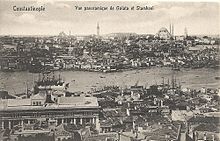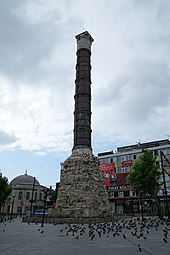Constantinople
![]()
The title of this article is ambiguous. For other meanings, see Constantinople (disambiguation).
![]()
Tsarigrad is a redirect to this article. See also: Tsarigrad Peak.
The city of Constantinople (now Istanbul) was founded by Dorian settlers from the Greek motherland around 660 BC under the name Byzantion (Byzantium). On 11 May 330 AD, the Roman emperor Constantine the Great made it his main residence, expanded it generously, and officially renamed it Nova Roma (Νέα Ῥώμη Nea Rhōmē, "New Rome"). In late antiquity (after the division of the Roman Empire), the city also claimed the rank of "Second Rome". After the death of Emperor Constantine in 337, the city was officially renamed Constantinopolis. It was the capital of the Byzantine Empire named after it ("Ostrom") and remained so continuously - apart from the conquest in the Fourth Crusade - until the conquest by the Ottomans in 1453. Under the names Kostantiniyye / قسطنطينيه and استانبول / Istānbūl it was then the capital of the Ottoman Empire until 1923.
From 1930 at the latest, the name Istanbul, which was already in use in the Seljuk and Ottoman empires, also gained international acceptance. As a prototype of an imperial city, it has been a world city since the 4th century.

Postcard from 1905
Spellings and translations
- Ancient Greek and Katharevousa: Κωνσταντινούπολις Konstantinoúpolis.
- Modern Greek (vernacular): Κωνσταντινούπολη Konstandinoúpoli; respectively "City of Constantine".
- Levantine-Italian: Cospoli (Romanian: Constantinopol)
- Ottoman Turkish: درسعادت Der-i saadet 'The Gate to Happiness', إسطنبول Istanbûl, قسطنطينيه Qusṭanṭīnīya; Stambul and many more.
- Modern Turkish: İstanbul
- In historical context: Constantinopolis, Constantinopol, Dersaadet
- In German (rare, only historical context): "Die Stadt der Reichen".
- The West Scandinavians (and Vikings) called the town Miklagard
Imperial Buildings
When Emperor Constantine founded a new centre for the Roman Empire at the old Byzantium between 324 and 330, this was to gradually replace Rome as the capital. In order to lend weight to the idea of a Nova Roma, this then also had to be architecturally expanded. Moreover, since Constantinople was Christian from the very beginning and Christianity became the state religion, without, by the way, renouncing the emperor cult, Constantinople got an appearance characterized by votive and memorial columns, forums, palaces, the Hippodrome and, of course, numerous Christian churches.
The oldest preserved monument in Constantinople is Constantine's Column. The formerly 52-meter-high column made of porphyry was originally crowned by a statue of Helios. The head of the sun god was surrounded by seven rays in which, according to legend, passion nails had been worked. Also, according to a 9th century tradition, the foundation of the column recovered a splinter from the cross of Christ, the palladion and other cult objects, some Christian and some pagan. In 1105 the statue was destroyed in a storm and replaced by a cross. The height of the column is now only 35 meters. It became the symbol of the city, and the last Byzantine chroniclers report that on the day of the conquest by Sultan Mehmed II, the city's inhabitants gathered around it early in the morning to wait for the saving angel of the Lord.
In addition to the Column of Constantine, it was above all the Hippodrome that formed the centre of the city and was the focal point of public life. Here the emperor and the people met, here the emperor demonstrated his power and therefore some representative objects can be found there. Along the Spina, the dividing wall between the two directional roads around which the chariots drove, Constantine and his successors erected statues and monuments. Among them were the obelisk of Theodosius, an Egyptian obelisk from the temple at Karnak, and the bronze Serpent Column from the 5th century B.C. This column had originally been erected by 31 Greek cities to commemorate the Battle of Plataiai in 479 B.C. directly opposite the Temple of Apollo at Delphi. Constantine I had the monument brought to Constantinople in 330. The golden bowl originally supported by this column was looted during the 4th Crusade. The heads of the serpents were destroyed by Muslims in the 17th or 18th century, the remains of one of the three heads can still be seen in the archaeological museum in Istanbul.
Under Emperor Theodosius, three forums were erected along the route of the imperial triumphal processions. On the Forum Tauri stood the honorary column of the emperor Theodosius, created after the model of the Trajanssäule in Rome. Further columns are the Arcadius column, Markian column as well as the Justinian column. This youngest of the columns is, like Constantine's Column, closely connected with the history of Constantinople. Inaugurated in 543, the 35 m high column bore an equestrian statue of Justinian I, three to four times life-size. When Mehmed II. conquered Constantinople, one of his first acts was to destroy this statue.
One of the city's central late-antique monuments, the 6th-century Hagia Sophia, now used as a museum, stands out. It was the largest place of worship in the world until the construction of Seville Cathedral. Immediately after the conquest of Constantinople, the new Turkish masters set about appropriating the building for the Islamic religion they had brought with them and redesigned it. In the process, not only were all the valuable Christian symbols removed and the precious mosaics destroyed or plastered over, but, in addition to various alterations, four large minarets were raised on the flanks of the church by three sultans.

Constantine's Column in July 2010, north side
Search within the encyclopedia